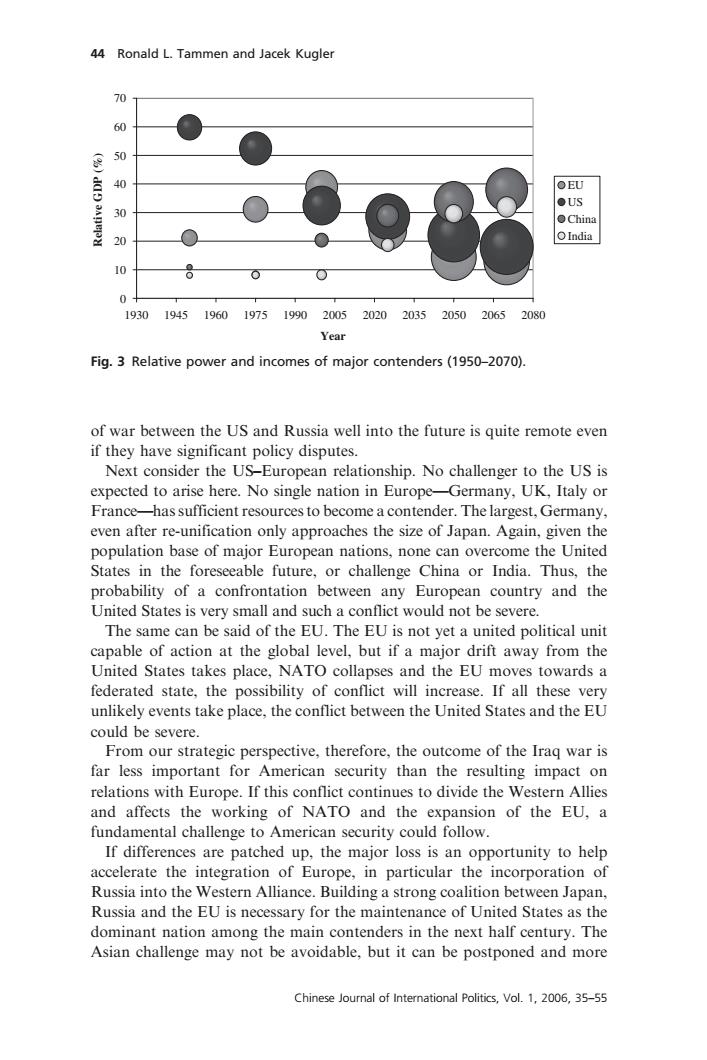正在加载图片...

44 Ronald L.Tammen and Jacek Kugler 70 60 50 40 OEU ●US China 20 OIndia 0 0 19301945196019751990200520202035205020652080 Year Fig.3 Relative power and incomes of major contenders(1950-2070). of war between the US and Russia well into the future is quite remote even if they have significant policy disputes. Next consider the US-European relationship.No challenger to the US is expected to arise here.No single nation in Europe-Germany,UK,Italy or France-has sufficient resources to become a contender.The largest,Germany, even after re-unification only approaches the size of Japan.Again,given the population base of major European nations,none can overcome the United States in the foreseeable future,or challenge China or India.Thus,the probability of a confrontation between any European country and the United States is very small and such a conflict would not be severe. The same can be said of the EU.The EU is not yet a united political unit capable of action at the global level,but if a major drift away from the United States takes place,NATO collapses and the EU moves towards a federated state,the possibility of conflict will increase.If all these very unlikely events take place,the conflict between the United States and the EU could be severe. From our strategic perspective,therefore,the outcome of the Iraq war is far less important for American security than the resulting impact on relations with Europe.If this conflict continues to divide the Western Allies and affects the working of NATO and the expansion of the EU,a fundamental challenge to American security could follow. If differences are patched up,the major loss is an opportunity to help accelerate the integration of Europe,in particular the incorporation of Russia into the Western Alliance.Building a strong coalition between Japan, Russia and the EU is necessary for the maintenance of United States as the dominant nation among the main contenders in the next half century.The Asian challenge may not be avoidable,but it can be postponed and more Chinese Journal of International Politics,Vol.1,2006,35-55of war between the US and Russia well into the future is quite remote even if they have significant policy disputes. Next consider the US–European relationship. No challenger to the US is expected to arise here. No single nation in Europe—Germany, UK, Italy or France—has sufficient resources to become a contender. The largest, Germany, even after re-unification only approaches the size of Japan. Again, given the population base of major European nations, none can overcome the United States in the foreseeable future, or challenge China or India. Thus, the probability of a confrontation between any European country and the United States is very small and such a conflict would not be severe. The same can be said of the EU. The EU is not yet a united political unit capable of action at the global level, but if a major drift away from the United States takes place, NATO collapses and the EU moves towards a federated state, the possibility of conflict will increase. If all these very unlikely events take place, the conflict between the United States and the EU could be severe. From our strategic perspective, therefore, the outcome of the Iraq war is far less important for American security than the resulting impact on relations with Europe. If this conflict continues to divide the Western Allies and affects the working of NATO and the expansion of the EU, a fundamental challenge to American security could follow. If differences are patched up, the major loss is an opportunity to help accelerate the integration of Europe, in particular the incorporation of Russia into the Western Alliance. Building a strong coalition between Japan, Russia and the EU is necessary for the maintenance of United States as the dominant nation among the main contenders in the next half century. The Asian challenge may not be avoidable, but it can be postponed and more 0 10 20 30 40 50 60 70 1930 1945 1960 1975 1990 2005 2020 2035 2050 2065 2080 Year Relative GDP (%) EU US China India Fig. 3 Relative power and incomes of major contenders (1950–2070). 44 Ronald L. Tammen and Jacek Kugler Chinese Journal of International Politics, Vol. 1, 2006, 35–55